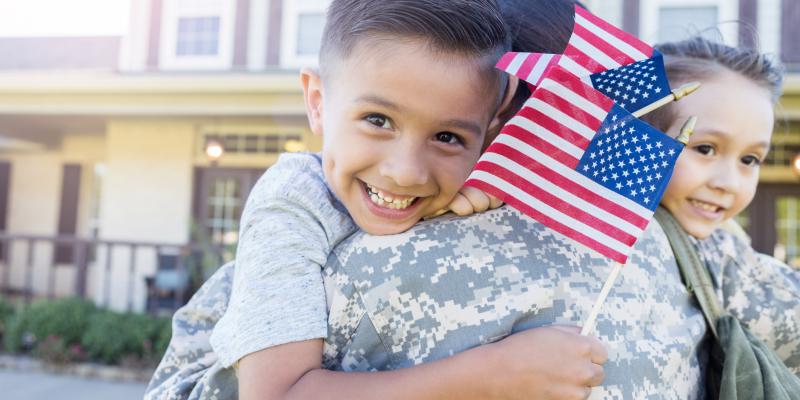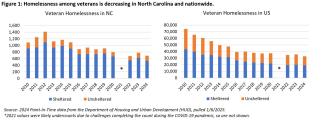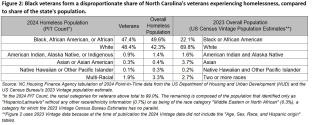
Homelessness has proven challenging to address in North Carolina and nationwide, as discussed in a recent Policy Matters Blog. Despite efforts by housing organizations and service providers, the number of North Carolinians experiencing homelessness remains high, increasing by 19.2% from 2023 to 2024, according to the US Department of Housing and Urban Development (HUD) Point-in-Time (PIT) Count. As overall homelessness in the state has increased, the number of veterans experiencing homelessness has reached nearly its lowest point since counting began twenty years ago. Of the 11,626 individuals experiencing homelessness on a single night in January 2024[i], 688 (5.9%) were veterans. This is an 11.5% decrease from 2023 when 777 veterans were homeless, 8.0% of the state’s homeless population[ii].
Nationally, there were approximately 32,900 veterans experiencing homelessness in 2024; 2.1% were experiencing homelessness in North Carolina[iii].
From 2010 to 2024, the number of veterans experiencing homelessness nationwide has decreased by 55.6% (or 41,200 individuals). North Carolina has seen a smaller, though noteworthy, decrease in homelessness among veterans: from 2010 to 2024, the number of veterans experiencing homelessness in the state has decreased 36.5% (or 396 veterans). This is a 51.3% decrease from the 2012 peak. During those years, the veteran population overall decreased, but by a smaller percentage. There were 27.5% fewer veterans in the nation and 15.2% fewer veterans in North Carolina in 2023 than in 2010.[iv]
Of the veterans experiencing homelessness nationally in 2024, 13,851 (42.1%) were unsheltered[v]. Of the 688 homeless veterans in North Carolina in 2024, 158 (23.0%) were unsheltered[vi].

The United States Department of Veterans Affairs (VA) has made concerted efforts to address homelessness among veterans, including increasing utilization of HUD-VASH (HUD-Veterans Affairs Supportive Housing) vouchers, increasing staff for street and community outreach and investing considerable financial resources for health care and employment services and expenses people face when they are moving from homelessness into housing (e.g., furniture). They operated with Housing First principles of rapid, streamlined entry into housing, with no preconditions like sobriety or treatment program enrollment. In addition to attributing the decline to Housing First principles, the VA also attributes the decline nationwide to the implementation of a computer system called Status Query and Response Exchange System (SQUARES) in 2015 that makes it easier to connect individual veterans experiencing homelessness with the services for which they are eligible[vii].
The VA reports that three states and 53 communities have effectively ended veteran homelessness as of October 2024, including the North Carolina communities Cumberland County/Fayetteville and Winston‑Salem[viii].
The PIT Count collects some demographic data for veterans that can be used to understand some of the characteristics of this population. The demographics of North Carolina’s veteran population experiencing homelessness mirrors the nation’s. For example, of the veterans experiencing homelessness in 2024, in North Carolina 91.1% identify as male and 8.3% as female; nationally 88.8% identify as male and 10.1% as female. Less than one percent identifies as non-binary or other both within North Carolina and nationally[ix].
People of color are found in greater percentages in the population of veterans experiencing homelessness in North Carolina than in the overall population. Their proportions are similar to the proportions in the overall homeless population[x].

Homelessness Response in North Carolina
For decades, many organizations and community members in North Carolina, like the North Carolina Department of Military and Veterans Affairs (DMVA), have worked collaboratively on behalf of North Carolinians experiencing homelessness.
- The VA Homeless Programs page provides information about resources for veterans experiencing homelessness. The Department of Veterans Affairs and the Department of Housing and Urban Development jointly administer the HUD-VASH program that provides rent assistance for low-income veterans to afford housing. In the past year, the VASH rules have been modified so more veterans are eligible for this resource.
- Local agencies in communities around the state operate shelters, transitional housing programs, rapid rehousing programs and permanent housing for people experiencing homelessness or coming out of it. Continuum of Care organizations (CoCs) administer homelessness resources to on-the-ground organizations in twelve regions across the state, and facilitate coordination and partnership among the region’s organizations that serve those who are homeless or at risk. The statewide nonprofit North Carolina Coalition to End Homelessness (NCCEH) staffs a statewide CoC for regions without a local CoC.
- Local Management Entities/Managed Care Organizations (LME/MCOs) help with housing search and facilitate the services necessary for vulnerable populations, including those experiencing homelessness, particularly those with disabilities, to access housing and stay safely housed.
- Various state and local agencies administer federal and state funds to provide rent assistance and finance the development, repair and operation of housing and shelters, including the NC Housing Finance Agency, the NC Department of Health and Human Services (NC DHHS) and the NC Office of Resiliency & Recovery (NCORR).
The NC Housing Finance Agency helps address homelessness through development of supportive housing, financing of affordable apartments and partnering with NC DHHS to administer rental assistance for vulnerable populations. These programs enable people experiencing homelessness and other vulnerable populations to live in targeted units within apartments developed using Low-Income Housing Tax Credits or in other housing in the community.
This year, the Agency is prioritizing veterans under the Supportive Housing Development Program (SHDP) through a separate competitive funding cycle specifically for veterans who are homeless or at imminent risk of homelessness. Interested applicants are encouraged to learn more about this opportunity by contacting @email.
Check out our other Policy Matters Blogs
--------------
[i] This figure came from the annual Point-In-Time (PIT) count, a count of individuals experiencing homelessness on a single night each year. The PIT data came from the Department of Housing and Urban Development (HUD), downloaded 1/6/2025, available here.
[ii] NC Housing Finance Agency tabulation of 2023 and 2024 Point-In-Time data from HUD, downloaded 1/6/2025, available here.
[iii] NC Housing Finance Agency tabulation of 2024 Point-In-Time data from HUD, downloaded 1/6/2025, available here.
[iv] NC Housing Finance Agency tabulation of 2010 and 2023 American Community Survey data from tables S2101 and DP05, available here and here. Information downloaded 5/29/2025.
[v] VA website on the Point-In-Time count, available here. Information downloaded 11/27/2024.
[vi] NC Housing Finance Agency tabulation of 2024 Point-In-Time data from HUD, downloaded 1/6/2025, available here.
[vii] Technology improves Veterans’ Access to Safe, Affordable Housing, Digital VA, published 1/26/2023, available here.
[viii] VA Homeless Programs, Ending Veteran Homelessness, retrieved on 11/1/2024, available here.
[ix] NC Housing Finance Agency tabulation of 2024 Point-In-Time data from HUD, downloaded 1/6/2025, available here.
[x] NC Housing Finance Agency tabulation of 2024 Point-In-Time data from HUD downloaded 1/6/2025, available here, and the US Census Bureau’s 2023 Vintage population estimate downloaded 1/6/2025, available here.